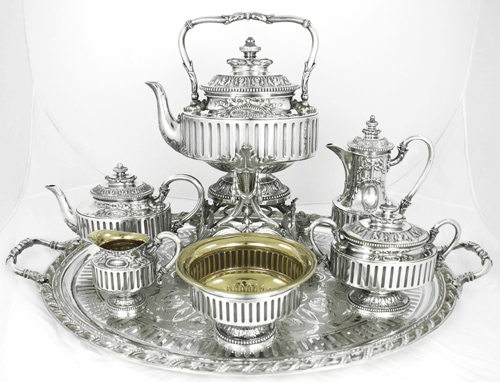
The History of That Tea Set
Tea isn’t quite so proper these days. There isn’t really the ceremony of bringing out a tea set, setting out a pot, milk and sugar, and drinking tea around the table from delicate tea cups. Tea seems more utilitarian – with thermoses and tumblers with strainers built in, tea makers that make whole pots of tea like coffee pots – there doesn’t seem to be as much gathering for a “tea”. Though every once and a while your grandma, or aunt, or maybe that random friends brings that tea set out of the dark and you remember what it is to have “tea time” again. There’s something beautiful and interesting entrenched in the tradition of having tea the way others have had tea before you and it’s all in that porcelain or silver set that you’re drinking out of. The history of that tea set is important and is maybe why you started drinking in the first place – whether drinking tea with dolls when you were little or the love came later in life – it’s important. So this, this is the history of that tea set, via Claire Masters in her article on Waco Trib:
The first tea sets were believed to have originated in China during the 2nd century BC. At that time and place, all teaware was made of porcelain. These ancient tea sets were “elemental and not as elaborate as today’s tea sets”. Historians believe the teapot as we know it was developed during the Song Dynasty.
A tea service can be used at a tea party or following a formal dinner. A service, along with all its separate pieces, is presented on a large tray. At a formal tea party, two pots are included, a smaller one for tea and a taller one for the coffee. For a formal reception, the hostess might appoint a close friend to pour. It is an honor to be invited to pour since the pourer is considered the guardian of the teapot, which implies sterling social graces. Some hostesses serve after-dinner coffee in the living room using the tray and pieces, minus the tea pot.
Tea culture came to Europe via the Portuguese trade ships of the 16th century. The political alliance between the two sea-faring nations of Portugal and Holland brought tea to the Netherlands, where residents developed their own ceremony to serve it. Some of the great houses there had little rooms set aside just for the serving of tea. The Dutch were the first to serve tea in public restaurants and taverns and were the first to serve tea with milk.
In early 17th-century Russia, Czar Alexis was presented with chests of tea by the Chinese embassy in Moscow. Tea took hold in Russia, where citizens developed the massive samovar, which was capable of dispensing up to 50 cups of tea.
This drink was quickly adopted by the English. In the beginning, the exotic commodity was enjoyed only by the wealthy because of its cost. As more and more tea flooded the island, it became available to most Englishmen. During the reign of England’s Queen Anne in the early 18th century, sugar was first offered to guests. The first silver sugar bowl made its appearance and joined all the other parts of the tea set. By mid-century, the tea and coffee service that we know today was well established on the tables of Europe and America. Dutchman Peter Stuyvesant, rather than an Englishman, brought the first taste of tea to New Amsterdam (New York) in the mid-17th century.
In the not quite yet United States, tea was the center of a revolutionary act, which became known as the Boston Tea Party. In 1773, revolutionary firebrand Samuel Adams led a troop of his compatriots, disguised as wild “Indians,” aboard an English ship loaded with tea. To refute the excess tax that would have inordinately burdened the colonists, the “Indians” dumped the entire precious cargo into the bay. Almost as effective as our Declaration of Independence, the Boston Tea Party became a symbol of revolt to the outraged King George III.
During the reign of Queen Victoria, the modern six-piece tea service was developed. It consisted of a teapot, creamer, sugar bowl, tea kettle, coffee pot and waste bowl. Today, though it is a popular drink in America, tea is especially favored by Englishmen of all ranks.
And as you know, tea is very popular now and is drunk even moreso, not only for its history, but for all of the health benefits it brings. Often now it is less pomp and circumstance and more a way to get the most you can out of life. It’s great to know though the history of drinking tea from that typical tea set. Maybe it’s a good reason to relive some of that history today.
Discover more from Hello Tea Cup
Subscribe to get the latest posts sent to your email.
No Comments